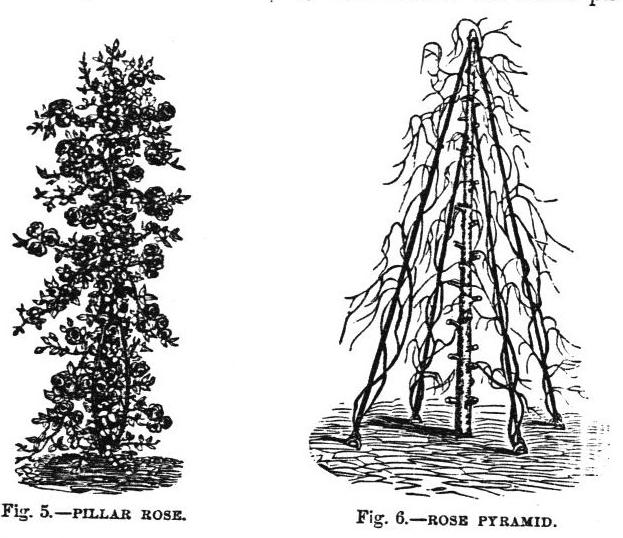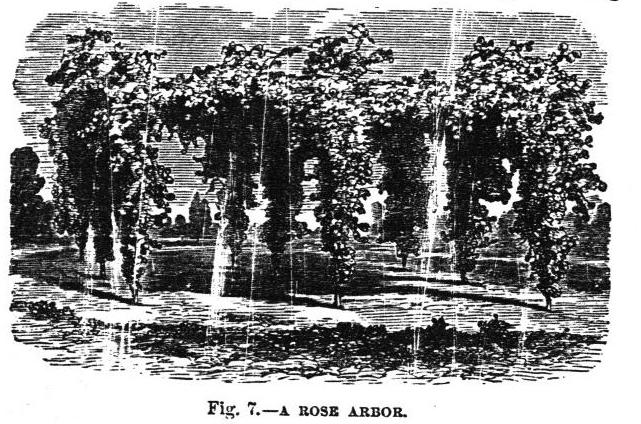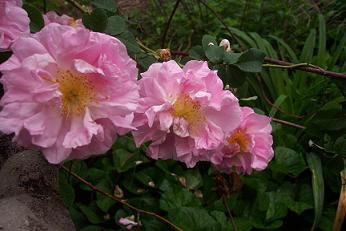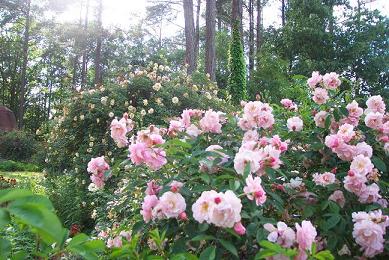More
Regency Rose FavoritesThis article goes through a few Regency
rose gardening techniques as well as listing some specific rose varieties
which were popular. The gardening techniques were not only popular in
the Regency, but are still in use even today.
Pruning, Training and Bedding
Keep in mind that we are not dealing with Hybrid Tea roses when we talk
about Regency roses, so pruning roses was vastly different in that period
than it is now, when we are trying to force reblooming. Pruning of old roses
was done with the following objects in mind:
- Prune upon transplanting, so that you don't kill the plant. If there
is excessive top material (branches and leaves) the disturbed roots will
not be able to support it, and the rose will die.
- Always prune out dead branches, or branches that cross others and
cause injury to the canes.
- To produce a symmetrical bush, you can trim down to two bud-eyes on
the cane. These eyes will sprout and you can then trim down the new canes
to two bud-eyes, and so on, until you obtain a nice, symmetrical shape.
- Prune summer-blooming (once blooming) roses immediately after blooming
(similar to how we treat azaleas today). This is generally mid to late
summer.
Favored Shapes
Roses were often shaped as follows:
- Pillars - where a two 1.5 or 2" square posts or trellis work of
iron rods was driven into the ground near the rose. The rose was planted
between the posts. As leading shoots appear, they are trained spirally
around the outside of the pillar. If properly trimmed, the entire pillar
will be a mass of bloom.
- Pyramid - where you create a pyramid (like a Tepee frame,
really) out of a central post and iron rods. The rose is trained over and
through the pyramid.

- Arbors - these are actually more rectangular - not curved
arches. They are often created and maintained in a similar fashion as
pillar roses, because they are trained up the pillars and then overhead in
festoons from one pillar to another.

- Pegging - this is a wonderful technique if you have the space.
Many of the older roses have very flexible canes. As the long canes are
thrown up, they are bent back down until they are nearly horizontal with
the ground. Small stakes (10 or 12" high) are used to anchor the canes.
When a rose is pegged in this fashion, rather like a starfish, it will
have blooms all along the canes. The display can be enormous and
spectacular when you think that a rose with even six foot canes can then
cover a circle 12' in diameter.
- Bedding roses - many gardeners considered China roses to be
"bedding" roses since without protection they would die in the winter.
They would be purchased and planted along with Verbenas and Salvias, and
could be expected to bloom all summer.
Popular Regency Varieties -
White Roses (Alba class)
- Alba Semi-plena, a summer rose (once blooming) with a rich rose
fragrance. Flowers are formed in large clusters. The bloom is white and
semi-double with lovely golden stamens. It will sucker and can reach up to
6' tall. Other names: Rosa alba semi-plena, 'Great Double White', 'Jacobite
Rose'. Ancient.
- Celestial, a summer rose with a very strong, sweet fragrance.
Very tall shrub (6') with large red prickles. Gorgeous semi-double
blossoms in clear pink, with a lovely boss of yellow stamens. This rose
should NOT be pruned too hard, and only when she finishes blooming in
mid-summer. Introduced in 1759.
 Damask Damask
- Celsiana, a summer rose with a rich, strong Damask rose
fragrance. My total favorite. The blossoms are semi-double
in clear pink with petals that look like soft silk. The fragrance is so
strong that during blooming, you can smell it across the yard. Never has
any diseases. This rose has one of the longest blooming periods of all the
old roses and is wonderful planted in a bed of bearded irises in shades of
yellow and apricot, or the cool shades of purple. Introduced in 1732.
French Roses (Gallica class)
- Bizarre Triomphant, a summer rose (once blooming) with a slight
rose fragrance. This rose is a compact shrub, 3' tall, that is nearly
devoid of prickles. The flowers are fully doubled and when open, quartered
with a green eye in the middle. They are a rich, deep wine-red that ages
to purple. Other names: 'Charles de Mills'. Introduced before 1790.
- 'Agathe Incarnata', a summer rose up to 4' tall. Clusters of
buds open to pale pink blossoms which are double and quartered with
quilled petals. Introduced prior to 1815.
- 'Berenice', a summer rose up to 5' tall, but tends to be lax.
Very large blooms in rich reddish-purple. Introduced by Vibert in France
in 1818.
- 'Henri Foucquier', a summer rose up to about 4' tall with
nearly thornless canes. The large, round blossoms are fully double in a
rich pink which fades to a lilac-pink. Introduced in 1811.
Noisette

- Blush Noisette, REBLOOMING! Lovely tall shrub 6' tall with pale
blush pink flowers held in huge clusters of up to 30 blossoms. The Small
blossoms open to a pale lilac-pink and age to white. May be used as a
pillar rose. Fruity, peppery scent. Introduced by the Noisette brothers,
Phillip and Louis, in Paris, after they received the original from John
Champneys in the United States. Introduced in 1817.
Portland
- Duchess of Portland, REBLOOMING! Small shrub reaching 3' tall
with a nice rose fragrance mixed with pear. This is a wonderful variety
for the front of the border as it stays small. The rich red buds are
produced in clusters and open to semi-double flowers in a lovely red. Does
require good care, however. This shrub is guessed to be named for Margaret
Bentinck, the second Duchess of Portland. It is further speculated that it
was discovered in her garden sometime around 1782.
Species
- Chestnut Rose - reblooms sporadically. Introduced to Europe
from Guangzhou, China around 1820 or so. The buds and hips look like
European horse chestnuts and are covered with spikes like burrs. Very
vigorous grower--may reach up to 8 feet tall. The foliage is remarkable as
the individual leaves are composed of 7-15 leaflets which make the plant
look like a giant fern. The blossoms are a gorgeous deep pink , and are
fully double with quilled petals (the petals curl into almost a tube)
alternating with flat petals. Slight rosy fragrance. Can be dated to 1814,
although I believe it was more common after 1820.
- Austrian Copper - a summer rose with fetid fragrance
(rotting meat). Very large (8' tall) shrub, prone to blackspot. The blooms
are single (5 petals) and are crimson orange. The back of the petals is
yellow. This was not a particularly popular rose because of the smell and
the fact that it could not be worked into the color scheme of most rose
gardens, which ranged from white, through pink to mauve, wine red, and
purple. Introduced in Austria in 1590.
- Rosa Multiflora Carnea - a summer rose. This MAY
be the rose mentioned in the list of class 8, as the Blush Cluster. This
is a double form of Rosa multiflora cathayensis, which was introduced from
China to Britain in 1804. This is a very tall rose (14') which can be used
as a climber for arbors or pyramids. The buds form in clusters and open
into small, flat, double blooms in pale pink that age to white. There is a
soft, spicy fragrance. Carnea is Latin for "flesh-colored". Introduced
around 1804.
|
|
